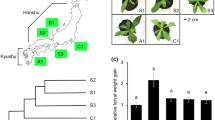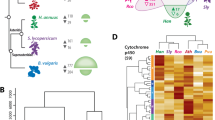Abstract
Induced plant resistance traits are expressed in response to attack and occur throughout the plant kingdom1,2. Despite their general occurrence, the evolution of such resistances has rarely been investigated3. Here we report that extrafloral nectar, a usually inducible trait, is constitutively secreted by Central American Acacia species that are obligately inhabited by ants. Extrafloral nectar is secreted as an indirect resistance4, attracting ants that defend plants against herbivores5. Leaf damage induces extrafloral nectar secretion in several plant species6,7,8; among these are various Acacia species and other Fabaceae investigated here. In contrast, Acacia species obligately inhabited by symbiotic ants9 nourish these ants by secreting extrafloral nectar constitutively at high rates that are not affected by leaf damage. The phylogeny of the genus Acacia and closely related genera indicate that the inducibility of extrafloral nectar is the plesiomorphic or ‘original’ state, whereas the constitutive extrafloral nectar flow is derived within Acacia. A constitutive resistance trait has evolved from an inducible one, obviously in response to particular functional demands.
This is a preview of subscription content, access via your institution
Access options
Subscribe to this journal
Receive 51 print issues and online access
$199.00 per year
only $3.90 per issue
Buy this article
- Purchase on Springer Link
- Instant access to full article PDF
Prices may be subject to local taxes which are calculated during checkout




Similar content being viewed by others
References
Walling, L. L. The myriad plant responses to herbivores. J. Plant Growth Reg. 19, 195–216 (2000)
Karban, R. & Baldwin, I. T. Induced Responses to Herbivory (University of Chicago Press, Chicago and London, 1997)
Thaler, J. S. & Karban, R. A phylogenetic reconstruction of constitutive and induced resistance in Gossypium. Am. Nat. 149, 1139–1146 (1997)
Price, P. W. et al. Interactions among three trophic levels: influence of plants on interactions between insect herbivores and natural enemies. Annu. Rev. Ecol. Syst. 11, 41–65 (1980)
Heil, M. & McKey, D. Protective ant-plant interactions as model systems in ecological and evolutionary research. Annu. Rev. Ecol. Evol. Syst. 34, 425–453 (2003)
Heil, M. Induction of two indirect defences benefits Lima bean (Phaseolus lunatus, Fabaceae) in nature. J. Ecol. 92, 527–536 (2004)
Heil, M. et al. Extrafloral nectar production of the ant-associated plant, Macaranga tanarius, is an induced, indirect, defensive response elicited by jasmonic acid. Proc. Natl Acad. Sci. USA 98, 1083–1088 (2001)
Wäckers, F. L., Zuber, D., Wunderlin, R. & Keller, F. The effect of herbivory on temporal and spatial dynamics of foliar nectar production in cotton and castor. Ann. Bot. 87, 365–370 (2001)
Janzen, D. H. Swollen-Thorn Acacias of Central America (Smithsonian Institution Press, Washington DC, 1974)
Agrawal, A. A. Induced responses to herbivory and increased plant performance. Science 279, 1201–1202 (1998)
Baldwin, I. T. Jasmonate-induced responses are costly but benefit plants under attack in native populations. Proc. Natl Acad. Sci. USA 95, 8113–8118 (1998)
Thaler, J. S. Jasmonate-inducible plant defences cause increased parasitism of herbivores. Nature 399, 686–688 (1999)
Kessler, A. & Baldwin, I. T. Defensive function of herbivore-induced plant volatile emissions in nature. Science 291, 2141–2144 (2001)
Creelman, R. A. & Mullet, J. E. Biosynthesis and action of jasmonates in plants. Annu. Rev. Plant Physiol. Plant Mol. Biol. 48, 355–381 (1997)
Wasternack, C. & Parthier, B. Jasmonate-signalled plant gene expression. Trends Plant Sci. 2, 302–307 (1997)
Heil, M., Baumann, B., Krüger, R. & Linsenmair, K. E. Main nutrient compounds in food bodies of Mexican Acacia ant-plants. Chemoecology 14, 45–52 (2004)
Raine, N. E., Willmer, P. & Stone, G. N. Spatial structuring and floral avoidance behavior prevent ant-pollinator conflict in a Mexican ant-acacia. Ecology 83, 3086–3096 (2002)
Agrawal, A. A. & Rutter, M. T. Dynamic anti-herbivore defense in ant-plants: the role of induced responses. Oikos 83, 227–236 (1998)
Cucurou, C., Battioni, J. P., Thang, D. C., Nam, N. H. & Mansuy, D. Mechanisms of inactivation of lipoxygenases by phenidone and BW755C. Biochemistry 30, 8964–8970 (1991)
Miller, J. T. & Bayer, R. J. Molecular phylogenetics of Acacia subgenera Acacia and Aculeiferum (Fabaceae: Mimosoideae), based on the chloroplast matK coding sequence and flanking trnK intron spacer regions. Aust. Syst. Bot. 16, 27–33 (2003)
Miller, J. T., Grimes, J. W., Murphy, D. J., Bayer, R. J. & Ladiges, P. Y. A phylogenetic analysis of the Acacieae and Ingeae (Mimosoideae: Fabaceae) based on trnK, matK, psbA-trnH, and trnL/trnF sequence data. Syst. Bot. 28, 558–566 (2003)
Wolfe, A. D., Xiang, Q. Y. & Kephart, S. R. Diploid hybrid speciation in Penstemon (Scrophulariaceae). Proc. Natl Acad. Sci. USA 95, 5112–5115 (1998)
Loughrin, J. H., Manukian, A., Heath, R. R. & Tumlinson, J. H. Volatiles emitted by different cotton varieties damaged by feeding beet armyworm larvae. J. Chem. Ecol. 21, 1217–1227 (1995)
Siemens, D. H. & Mitchell-Olds, T. Evolution of pest-induced defenses in Brassica plants: Tests of theory. Ecology 79, 632–646 (1998)
Heil, M., Fiala, B., Baumann, B. & Linsenmair, K. E. Temporal, spatial and biotic variations in extrafloral nectar secretion by Macaranga tanarius. Funct. Ecol. 14, 749–757 (2000)
Koch, T., Krumm, T., Jung, V., Engelberth, J. & Boland, W. Differential induction of plant volatile biosynthesis in the lima bean by early and late intermediates of the octadecanoid-signaling pathway. Plant Physiol. 121, 153–162 (1999)
Baldwin, I. T. et al. Quantification, correlations and manipulation of wound-induced changes in jasmonic acid and nicotine in Nicotiana sylvestris. Planta 201, 397–404 (1997)
Meimberg, H., Wistuba, A., Dittrich, P. & Heubl, G. Molecular phylogeny of Nepenthaceae based on cladistic analysis of plastid trnK intron sequence data. Plant Biol. 3, 154–175 (2001)
Taberlet, P., Gielly, L., Pautou, G. & Bouvet, J. Universal primers for amplification of three non-coding regions of chloroplast DNA. Plant Mol. Biol. 17, 1105–1109 (1991)
Johnson, L. A. & Soltis, D. E. MatK DNA sequences and phylogenetic reconstruction in Saxifragaceae s. str. Syst. Bot. 19, 143–156 (1994)
Acknowledgements
We thank D. Davidson, J. Gershenzon, I. Baldwin, G. Stone, C. Kost and G. Pohnert for critically reading earlier versions of the manuscript, K. Heil and B. Baumann for help with field work, A. Kreiner and F. Thiele for taking care of greenhouse plant, and M. Sousa for species determination. Financial support by the Deutsche Forschungsgesellschaft and the Max-Planck-Society is acknowledged.
Author information
Authors and Affiliations
Corresponding author
Ethics declarations
Competing interests
The authors declare that they have no competing financial interests.
Supplementary information
Supplementary Discussion
This discussion provides an overview on the available information concerning phylogenetic relations within the genus Acacia and among the genus Acacia and related genera. It places the phylogenetic analysis presented here in a broader context. Supplementary references are also included. (DOC 45 kb)
Supplementary Figure 1
Results of a phylogenetic analysis of published trnK intron data combined with those of species investigated here: inducible and non-inducible Acacia species belong to the monophyletic subgenus Acacia, while the (inducible) non-Acacias appear in neighboring groups. This confirms the ancestral state of inducible EFN secretion. (DOC 46 kb)
Supplementary Figure 2
The position of the species investigated here in a broader phylogenetic context: species with inducible EFN secretion appear in different parts of the phylogenetic tree, while species exhibiting constitutive EFN flow form one single clade, further supporting the derived state of this character. (DOC 34 kb)
Rights and permissions
About this article
Cite this article
Heil, M., Greiner, S., Meimberg, H. et al. Evolutionary change from induced to constitutive expression of an indirect plant resistance. Nature 430, 205–208 (2004). https://doi.org/10.1038/nature02703
Received:
Accepted:
Issue Date:
DOI: https://doi.org/10.1038/nature02703
This article is cited by
-
Ontogenetic trajectories of direct and indirect defenses of myrmecophytic plants colonized either by mutualistic or opportunistic ant species
Oecologia (2019)
-
Induction and relaxation of extrafloral nectaries in response to simulated herbivory in young Mallotus japonicus plants
Journal of Plant Research (2018)
-
Growth form rather than phylogenetic relationship predicts broad volatile emission patterns in the Brassicaceae
Plant Systematics and Evolution (2017)
Comments
By submitting a comment you agree to abide by our Terms and Community Guidelines. If you find something abusive or that does not comply with our terms or guidelines please flag it as inappropriate.



